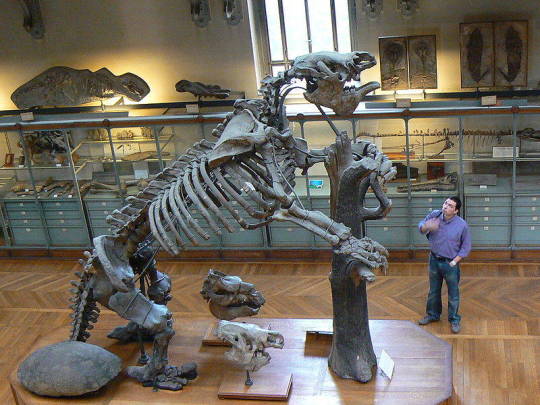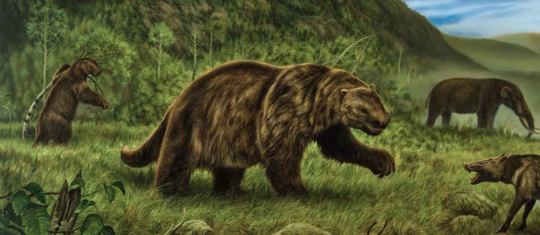#GIANT GROUND SLOTH
Note
Giant ground sloth for a suggestion! <3

I have Megalonyx!! I’ve been meaning to give them an edit, I feel like I could better capture their face in my style now :D (they were in Batch 1, I’ve been updating some of these designs as needed)
Megatherium and Thalassocnus are both in my queue too, but lemme know if there’s any other specifics!
#art#my art#paleoart#paleontology#science#illustration#giant ground sloth#megalonyx#paleo party#paleo party request
44 notes
·
View notes
Text

Party like a ground sloth, because it’s Fossil Friday! This image, snapped circa 1957 depicts giant sloths on display in the Museum. During the Pleistocene, a wide array of ground sloths lumbered across North and South America. Some, like the island-dwelling Megalocnus rodens, evolved to be long-distance swimmers. Others, like the mighty Megatherium, were among the largest land mammals to ever live. The biggest ground sloths could have weighed up to 8,800 lbs (4,000 kg)—the size of an elephant! Most of these mammals died out at the end of the Pleistocene. There is also evidence that ground sloths and early humans used the same caves, but not necessarily at the same time.
See giant ground sloths and more on the Museum's fourth floor! We're open daily from 10 am–5 pm. Plan your visit.
Photo: Image no. 324981 / © AMNH Library
#science#amnh#museum#fossil#nature#natural history#animals#paleontology#fact of the day#did you know#sloth#lestodon#megatherium#ground sloth#giant ground sloth#megafauna#fossil friday#natural history museum#museum of natural history
412 notes
·
View notes
Text

Ko-fi Creature Commission - Horseshoe Crab + Giant Ground Sloth
#shire draws#creature design#kofi#horseshoe crab#giant sloth#ground sloth#giant ground sloth#monster design#animal bingo
544 notes
·
View notes
Text
eating an avocado with an air of wistful melancholy because I’m thinking about how much I wish the giant ground sloths were still here
804 notes
·
View notes
Text
does this to my mutuals
youtube
#g/t#giant tiny#personal#giants#giant ground sloth#megatherium#zoo tycoon 2#zoo tycoon 2 extinct animals#calvin baretto#Youtube
54 notes
·
View notes
Text
Giant Ground Sloth 🦥💖
Two-toed Sloth 🦥💖
Three-toed Sloth 🦥💖
Sloths 💖🦥💖🦥💖🦥💖
Like if you agree 💕
Reblog if you agree 💞
#ghostie mumbles#sloth#giant ground sloth#two-toed sloth#three-toed sloth#2-toed sloth#3-toed sloth#ground sloth
33 notes
·
View notes
Text

Daily scribbles 23 - giant ground sloth
#ollyneanderthal scribbles#art#cartoon#illlustration#doodle#sloth#giant ground sloth#artists on tumblr
60 notes
·
View notes
Photo


I didn’t draw as much as I was expecting to on my DC trip, but I did manage to jot down some creatures at the Natural History Museum!
94 notes
·
View notes
Text
Time Travel Poll Winner Second Round Match Up 2:
These Questions are the winners from the previous iteration.
Please add new suggestions below, if you have them, for future consideration.
45 notes
·
View notes
Text
Screaming, crying, eating guacamole
feel like shit just want him back

155 notes
·
View notes
Text

Glyptodon and Megatherium from The past and present life of the globe. Being a sketch in outline of the world’s life-system by David Page, 1861, after Benjamin Waterhouse Hawkins
https://archive.org/details/pastpresentlifeo00pagerich/page/163/mode/1up
#glyptodon#megatherium#giant ground sloth#past and present life of the globe#david page#1861#benjamin waterhouse hawkins
6 notes
·
View notes
Text








Megatherium known as the giant ground sloth or the megathere is an extinct genus of ground sloth which lived throughout South America from the Pliocene to Pleistocene some 5 million to 12,000 years ago. The first known remains of Megatherium consisting of a mostly complete skeleton were discovered in 1788 by Manuel Torres, on the bank of the Luján River in Argentina. The fossil was shipped to Museo Nacional de Ciencias Naturales in Madrid the following year, where it remains. It was reassembled by museum employee Juan Bautista Bru in 1795 and subsequently described by Georges Cuvier in 1796. Cuvier assigned the fossil the scientific name Megatherium americanum from the Greek méga 'great' and theríon 'beast' and americanum being a reference to the Americas. In the centuries to follow dozens of well preserved specimens have been recovered representing some 8 species considered valid: M. americanum, M. altiplanicum, M. gallardoi, M. istilarti, M. medinae, M. parodii, and M. sundti which are separated into the two sub-genuses of Megatherium and Pseudomegatherium. With the largest species reaching some 20ft (6m) in length, 7ft (2.1m) tall when on all fours, and 8,400 to 10,100lbs (3,810 to 4580kgs) in weight, megatherium surpassed most modern elephants in size making it not only one of the largest xenathrans but one of the largest mammals known to have ever existed. Megatherium had a robust skeleton with a large pelvic girdle and a broad muscular tail. Its large size enabled it to feed at heights unreachable by other contemporary herbivores. Rising on its powerful hind legs and using its tail to form a tripod, Megatherium could support its massive body weight while using the curved claws on its long forelegs to pull down branches. These large animals likely lived in small groups feeding during the day before spending there nights resting inside of caves and large burrows the animals likely dug using there massive claws. Megatherium became extinct around 12,000 years ago during the Quaternary extinction event, which also claimed most other large mammals throughout the world. The extinction coincides with the settlement of the Americas, and multiple kill sites where M. americanum was slaughtered and butchered, suggesting that human hunting helped caused the sloths extinction.
Art belongs to the following creators:
Megatherium Mother and Baby: Mark Witton
https://www.redbubble.com/i/art-board-print/Megatherium-by-MarkWitton/40411556.TR477
Megatherium: Brian Engh
Lost World - Megatherium: Rob Brunette
https://www.artstation.com/artwork/3dbQXY
#pleistocene pride#pleistocene#pliestocene pride#pliestocene#cenozoic#ice age#stone age#giant sloth#sloth#ground sloth#giant ground sloth#megatherium#pliocene#south america#megafauna#prehistoric#prehistoric animals
13 notes
·
View notes
Text
Megatherium, the giant ground sloth

#paleoart#paleontology#mammal#sloth#giant sloth#giant ground sloth#pleistocene#ice age#megatherium#natural history#extinct animal
29 notes
·
View notes
Text
Evidence of artefacts made of giant sloth bones in central Brazil around the last glacial maximum
Published 12th July 2023
A study on the remains of an extinct giant ground sloth ,Glossotherium phoenesis, includes dermal bones with three human-modified specimens. Traceological analysis by optical microscopy, non-destructive scanning electron microscopy, UV/visible photoluminescence and synchrotron-based microtomography is performed to study these artefacts further.



Modified sloth osteoderm and analysis
These specimens supports the hypothesis that humans were in South America thousands of years before the extinction of the Pleistocene megafauna in the continent. This evidence might suggest that the human presence in South America was not the main agent responsible for the megafauna extinction.
It is suggested these modified osteoderms were probably used as personal ornaments, based on use-wear traces and smoothing deformation.
Source:
#fossil#paleontology#prehistoric#extinct#science#extant#early humans#human evolution#giant sloth#giant ground sloth#artefact#artefacts
11 notes
·
View notes
Text

3 notes
·
View notes
Photo



Big Animal
33 notes
·
View notes